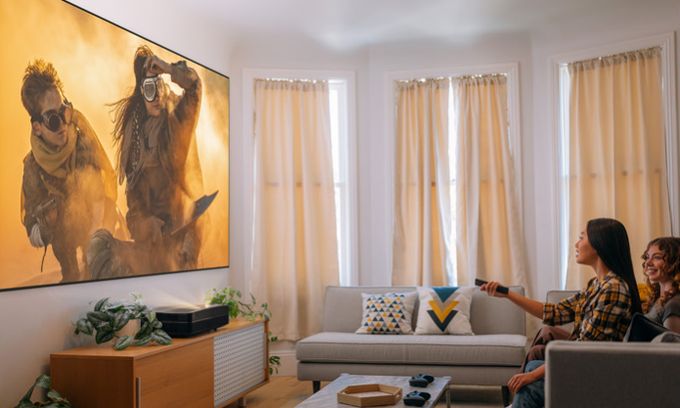Growing popularity of UST (Ultra Short Throw) projectors has been going on for several years. More and more consumers are choosing them as an alternative to TV in the living room. Indeed, prices for UST 4K laser projectors today range from $ 2,000 to $ 3,500. For comparison, the price range of 65-inch OLED, QD-OLED and QLED miniLED TVs is also $ 2,000 – $ 3,500. But projectors offer a huge image size from 100″ to 150″, slightly inferior in image quality.
TV vs projector
A few years ago, the difference in their image quality was significant.
Brightness
The viewer perceives direct light flux from the TV screen. When using a projector, we perceive a re-reflected light flux, which is significantly smaller. For example, the brightness of expensive projectors rarely exceeds a few hundred nits. But even budget TVs deliver 400 nits and up.
However, brightness is important only for 2 purposes. First, it improves HDR performance. But satellite and cable TV only offers SDR content due to network bandwidth limitations. In addition, brightness compensates for ambient light that makes the image look dull and pale.
Contrast
OLED panels and LCD TVs with miniLED backlight provide superb contrast with deep blacks. The contrast of DLP and 3LCD projectors is much lower. To be fair, LCoS projectors (Sony SXRD / Silicon X-tal Reflective Display, JVC D-ILA / Digital Direct Drive Image Light Amplifier and Canon AISYS / Aspectual Illumination System) also provide ‘infinite’ contrast. This technology uses the light transmission instead of re-reflectivity. LCoS provides perfect blacks due to the tiny width of the gaps between the liquid crystals which reduces light scattering to min.But they price starts at $ 5,000.
Native resolution
Even many budget modern TVs provide native 4K resolution. Of course, projector manufacturers also offer models with 4K (3,840 x 2,160) chipsets, but they are too expensive.
However, in recent years, manufacturers have successfully solved these and other problems. For example, the wireless technologies for screen mirroring and streaming have eliminated the problem of limited content. UST design eliminated the problem of the mid-focal models with wires on the floor, which is solved only with the help of a complex ceiling mount. As known, UST models are placed near the screen.
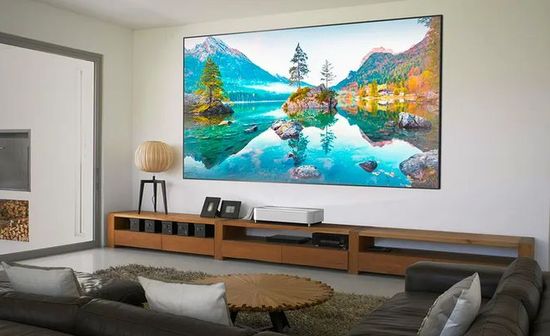
4K UST laser projectors
Differences in brightness, contrast and resolution have also been successfully minimized. Modern CLR (ceiling light rejection) and ALR (ambient light rejection) screens reduce dimming requirements, providing acceptable quality even in diffuse daylight. In addition, modern projectors mainly use an SSL (Solid State Light Source) light engine based on ADLP 3.0 and ADLP 4.0 technologies with laser LEDs. Their brightness varies from 2,000 ANSI Lumen to 4,000 ANSI Lumen, which practically eliminates this problem. Moreover, ADLP 4.0 (Advanced Laser Phosphor Display)-based triple-laser RGB light source have expanded the color gamut to an unprecedented 107% of BT.1020 color space.
The problem of the high price of 4K projectors has been successfully solved with the help of pixel shift technology, which is brilliantly implemented in DLP DMD (Digital Micromirror Device) chipsets from Texas Instrument. It’s called XPR (Xpanded Pixel Resolution) technology.
In fact, 2 million micromirrors of a relatively cheap 1080p chipset with XPR support displays 8 million pixels. Its operation principle is simple and elegant. The DLP 1080p chipset splits 8 million pixels of 4K content into four parts of 2 million pixels each. It then sequentially plays 4 separate 1080p frames diagonally shifted by half a pixel from each other.
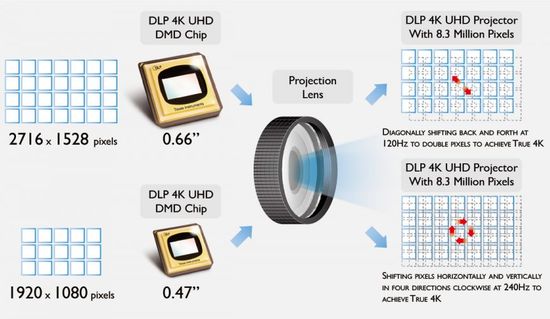
Strictly speaking, at any given moment, a projector only displays 2 million pixels on the screen. But our vision and brain do not perceive the micro-delay due to the high frequency, creating the illusion of a clearer image. For pixel shift, the projector uses the lens tilt using 4 electromagnets of the XPR module.
Today, the difference in image quality between TVs and projectors has been reduced to min. As a result, they are increasingly pushing TVs out of living rooms, offering twice the screen size for the same price.
Philips projectors
Probably, Philips can hardly be positioned as one of the leaders in the projector segment. However, the impeccable reputation of the company guarantees the high quality of products under this brand, ensuring their marketing success.
In fact, the Philips projector range includes DLP / LCD portable GoPix, PicoPix and NeoPix projectors with LED light engine and with WVGA / FHD resolution, and the Screeneo series.
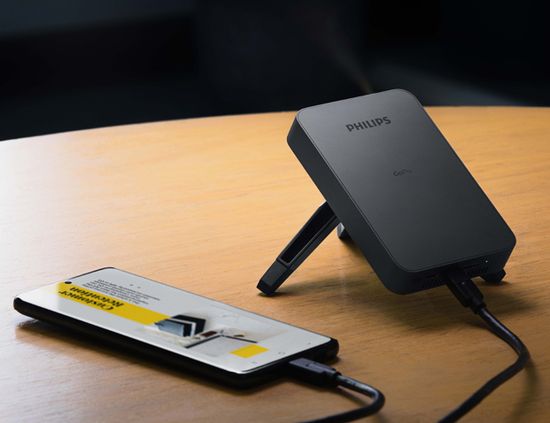
The evolution of Philips Screeneo models lasts 10 years and includes:
– Screeneo 1550 (2013) – LED / WXGA / 700 Lumens;
-‘- 1590 (2014) – WiFi;
-‘- 1690 (2015) – 1,000 Lumens;
-‘- Screeneo 2.0 (2016) – lamp / 1080p / 2,000 Lumens / UST;
-‘- Screeneo U3 (2018) – lamp / 1080p / 2,200 Lumens / Android OS;
-‘- U4 (2022) – RGB-B LED / 1080p / 400 ANSI Lumens / Android OS;
-‘- Screeneo U5 (2022) – laser phosphor (ADLP 3.0 ) / 4K / 2,200 ANSI Lumens / UST / Android TV and ChromeCast built-in.
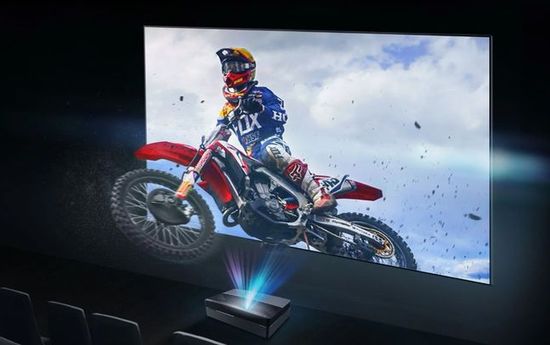
Thus, the latest Philips Screeneo U5 joins the list of ultra popular 4K laser UST projectors as an alternative to traditional TV in the living room.
Given the fierce competition in this segment, its marketing prospects are mainly dependent on price. As known, Philips is using crowdfunding for this product. Screeneo U5 is available at indiegogo.com. The lowest price was obtained on June 18, 2023 12:01 pm and was only $ 1,699. Including a Cyber Week 48% discount, the Screeneo U5 price was $ 1,790 (€ 1,699). But its ‘normal’ street price ranges from $ 3,300 to $ 3,600, which is in line with similar models.
Screeneo U5
Main specs:
– brightness – 2200 ANSI Lumens;
– contrast – 1,483:1 (full on/off);
– 80″-150″ screen from (0.2 – 0.7m) Throw Distance at 0.21:1 Throw Ratio (120″@11″).
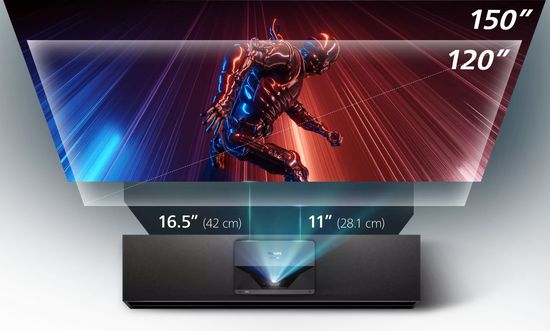
– Dolby Vision compatibility (improved processing for light and dark scenes), HDR10 and HLG support, color reproduction up to 12 bit, auto light dimming, color gamut of 130% BT.709;
– 2x 10W internal speakers, 4ch Dolby Atmos, DTS HD and Dolby Digital 5.1;
– Full HD 3D;
– Android TV 11 and ChromeCast built-in (screen mirroring from phone, tablet or laptop).
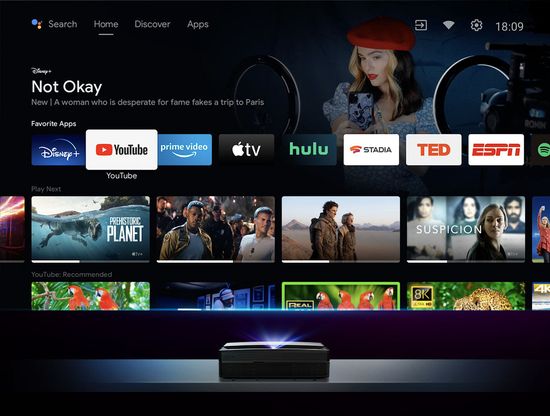
– 4k@60fps refresh rate;
– input lag – 36,9ms / 18,5ms (ALLM – Auto Low Latency Mode in games) for 1080p@120Hz;
– FlowMotion 4 MEMC+ technology (4K and 1080p compatible, MEMC- motion estimation motion compensation, frame interpolation).
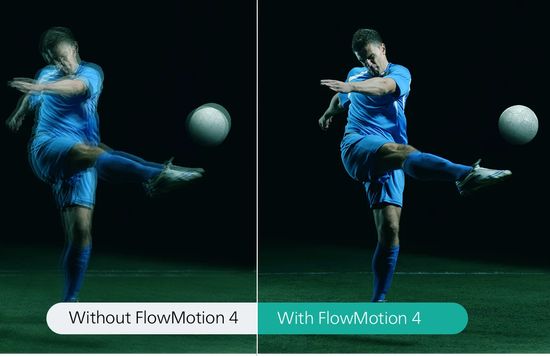
– autofocus and 8-point keystone correction;
– OK Google Ready;
– Bluetooth 5.1 + Wi-Fi MIMO Dual Band (2,4 / 5 Ghz);
– inputs – HDMI 2.1 with CEC + HDMI 2.1 with eARC/CEC;
– 2-year warranty.
Conclusion
Pros
– Android TV 11;
– Philips impeccable quality and 2-year warranty;
– Full HD 3D;
– UST design;
– FlowMotion 4 MEMC+ technology;
– 2x 10W internal speakers;
– 8-point keystone correction.
Cons
– € 3,500 is expensive vs competitors;
– only 2200 ANSI Lumens max brightness (premium models from $ 3,000 provide from 2000 ANSI Lumens to 4000 ANSI Lumens);
– only 1,483:1 (full on/off) contrast.
The evaluation of marketing prospects directly depends on Screeneo U5 price. The expected street price will be ~ € 3,500 (without crowdfunding). Of course, Philips is unlikely to use it to raise funds for the projector production. Most likely, the company uses it as an alternative method of sales.
The specs and functionality of the projector is quite consistent with the premium level. For reference, this list includes:
–BenQ V5000i – $ 3,500;
–Visionair-e Platinum Vision 3000 – $ 3,750;
– LG HU715Q – $ 3,000;
–Epson EB-810E – $ 3,300;
– Epson EpiqVision Ultra LS800 – $ 3,120;
– CHiQ B8U and B7U – $ 3,120 and up to $ 2,000;
–Optoma CinemaX D2 – $ 2,700;
–Formovie Theater – $ 3,000;
–Hisense PL1 – € 2,085;
–Hisense PX1-PRO – $ 2,700.
With prices up to $ 3,000 / € 3,000, its value for money is very competitive. But exceeding this level can significantly overshadow its prospects.
This video showes Philips Screeneo U5 4K UST laser projector.
